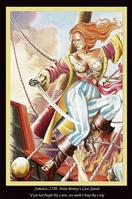Michael Robinson, Sunday Gleaner Writer

'We have all of this history and we don't do anything with it. If it had taken place anywhere else in the world this story would have been exploited to the max - movies, theme parks, the whole thing!'
IN THE golden years of piracy on the high seas there were two women who made a name for themselves as the only females plying the trade right here in the Caribbean.
Anne Bonny and Mary Read captured ships and treasure while establishing themselves as formidable combatants. Their stories are steeped in the stuff of legend, and facts are difficult to separate from fiction at this point. The strength of character and independent spirit of these two pioneers are, however, undisputable.
Bonny's story appealed to Andrea Haynes-Peart at a time when the artist was working on a new portfolio of work. "I wanted to do a fantasy piece," she says, "but I'm uncomfortable with gratuitous fantasy - it needs to have some content to it."
Haynes-Peart was drawn to this indomitable figure who ran away as a young girl to be with 'Calico' Jack Rackham, the pirate who allegedly invented the skull and crossbones emblem that eventually came to be associated with all pirates.
'Fantasy piece'

Anne Bonny's Last Stand digital painting (2008). - Photos by Michael Robinson
The compelling 'fantasy piece' has been created entirely on the computer. Having discovered and explored the digital medium using Corel Painter X, Haynes-Peart is now spreading her artistic wings with a strong and emotive vision of Bonney's last stand.
Stories that have survived time, including versions from Bonny's descendants, give us an intriguing picture of the woman. Born in Ireland, her rebellious and violent nature was apparent from an early age. She is said to have stabbed a servant in the stomach when she was just 13. Later, while living in the Caribbean, she started hanging out and drinking in pubs with pirates. Not long after that Bonney met Calico Jack, so named for his love of colourful cotton garments. The two stole a ship and went to sea.
"She's such a juicy historical character," says Haynes-Peart. She considers both women feminist figures and that powerful energy infuses the work with a super-realistic quality. "We have all of this history and we don't do anything with it," the artist continues.
Andrea believes that Jamaica's history is a vastly untapped resource of creative fodder. "If it had taken place anywhere else in the world," she remarks amid laughter, "this story would have been exploited to the max - movies, theme parks, the whole thing!"
Women were not allowed onboard pirate ships, certainly not as part of the crew, so Bonny had to disguise herself as a man. She fought alongside the men as fiercely as the best of them. The first man to discover her disguise was stabbed through the heart by Bonney.
Disguise
English-born Mary Read joined the crew and she, too, initially disguised herself as a man. The women seem to have been eventually accepted by the crew and their identities were revealed by Jack, the ship's captain.
Bonny was pregnant for Calico Jack when the ship was discovered off Jamaica's shores by government agents. The pirate crew had been drinking and were caught unawares. All the men, Jack included, hid in the hold while the two women fought bravely to defend the ship.
This is the poignant scene captured by Andrea's stylus. She depicts Anne Bonny with a pistol in her waist hanging on to a rope ladder, sword flying. Menacing hands below are trying to grab (and stab) her, but she is more concerned with an unseen threat. Her blazing green eyes are directed to a point off to the left, adding the depth of an imaginary plane to the two-dimensional piece.
The digital brush strokes are every bit as sensuous as if the artist had used sable bristles. Flames send smoke billowing behind her, lending an urgency to the scene and mirroring the heart of this cornered warrior. Complementary blues and reds intensify the drama.
Realism

Andrea Haynes-Peart in her 'digital and analog' studio.
Textures ranging from smoke to the wood of the mast to Bonny's hair, boots and undergarments add realism. Andrea's deft skill as a painter blends synergistically with the software's amazing versatility. The result is an instant classic. A page from Jamaica's sordid history as the one-time 'richest country in the world'.
Andrea is understandably excited about the piece. She plans to enter it in the National Gallery's biannual exhibition later this year. "The National Gallery is a place where you're encouraged to experiment and explore and come up with new things and new ways of doing things," she says, "and this [piece] surely is all of those things."

